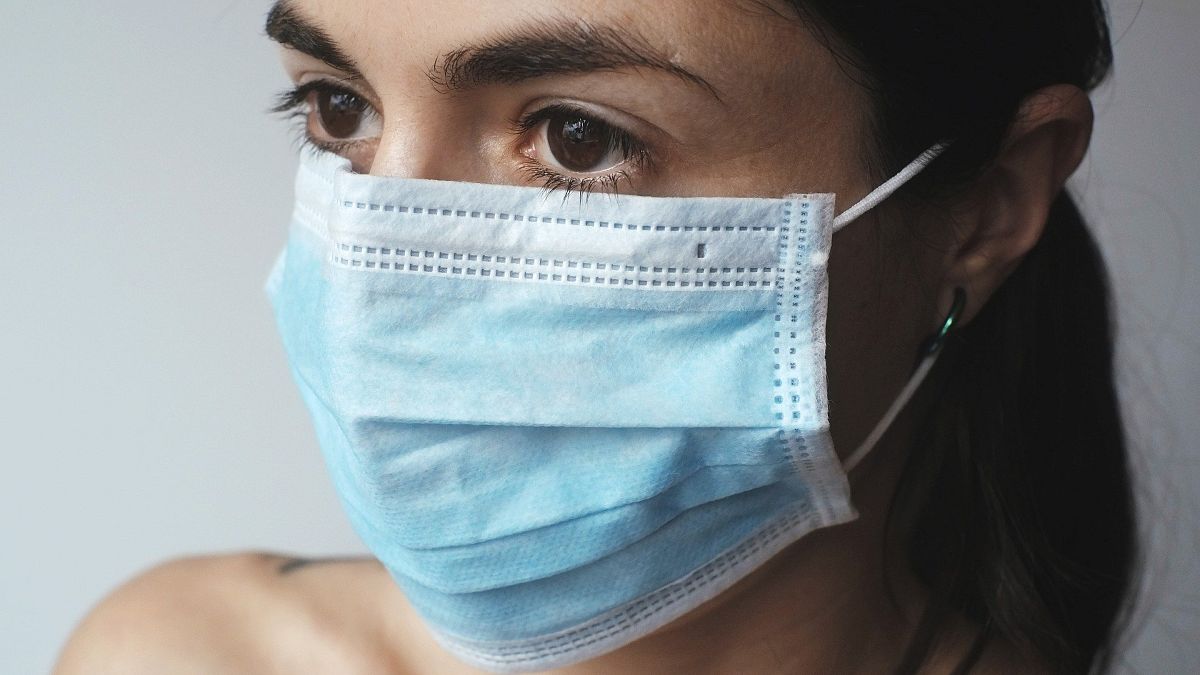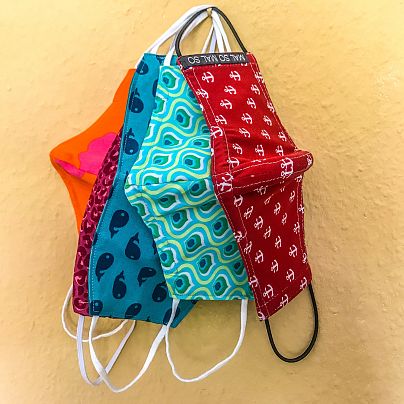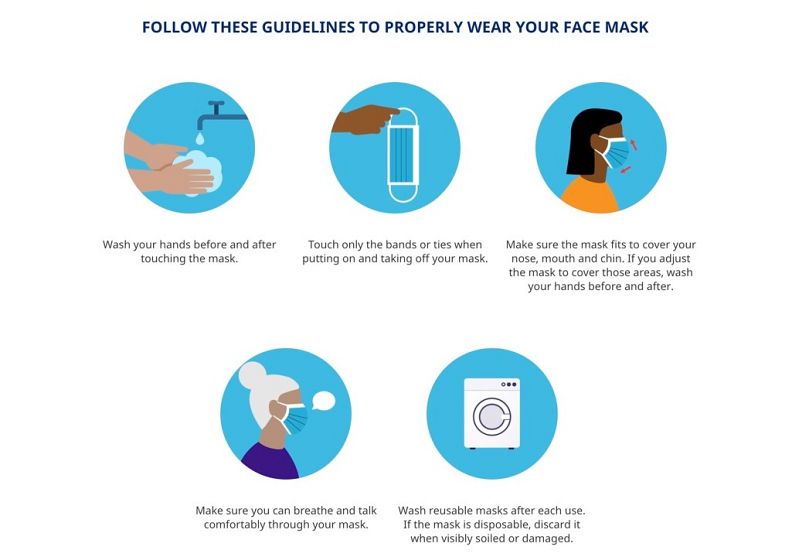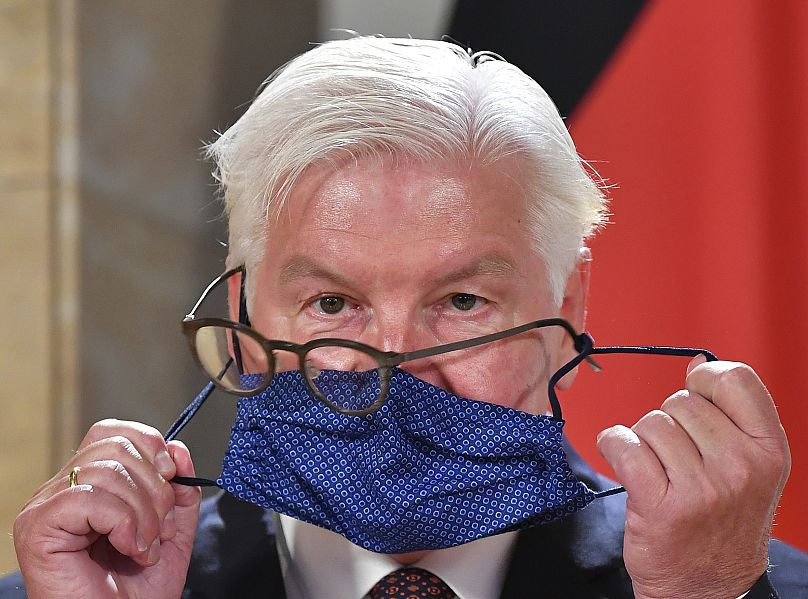Treat your mask like your underwear — change it every day. Euronews spoke to an expert to see what habits you should adopt with your COVID-19 mask.
Is using a face mask to prevent the spread of COVID-19 as easy as throwing it on and not worrying about it until you return home?
In short, no.
As more and more governments across Europe look to face masks to help curb the spread of the virus, here's how you can make sure you're wearing your mask efficiently, based on the latest official health advice.
We've also asked nurse educator Jade Flinn from Johns Hopkins Biocontainment Unit to myth-bust some common topics including how to properly wear your mask and what action you can take if you have a beard or wear glasses.
What type of mask is best?
First things first: should you be wearing a cloth mask, disposable face covering, a visor or full PPE?
When it comes to the choice between paper or fabric masks, Flinn says that the essential thing to remember is that they must cover both your nose and mouth regardless of the material they are made from.
"The purpose of the mask is to contain droplets that are produced by either our nose or mouth when speaking so that they don't spread into the environment," Flinn said.
If you're using face protection made from material, it should not be knitted or made from a fabric with a loose stitch, breathable cotton is best, she added. It should also ideally have several layers — this will make it more effective than most disposable paper masks.
She said some evidence suggests that surgical-grade masks contain droplets better than cloth masks, but added that in the midst of a pandemic, PPE needs to be conserved for front-line healthcare workers.
She warned that some companies have tried to emulate the look of PPE, while the masks aren't as effective.
An acid test to quickly see how well your mask will contain droplets is to try to blow a candle out while you are wearing it and see if you can move the flame or is extinguish it.
Plastic visors that attach to a headband will not sufficiently contain the droplets of the wearer, so they should be used in connection with a face mask, but they do prevent droplets from others going into the wearer's eyes.
How should you put the mask on?
Masks aren't just intended to protect the person wearing them but also those around them.
We've all seen the memes — don't leave your nose sticking out, this renders your mask ineffective.
Flinn says it's fine to adjust the ties of your mask or twist them around their ears to make it tighter, so long as it is doing a good job of covering your nose and mouth.
If the face covering is doing this effectively, in most cases, it doesn't matter which way up you wear it.
You should also wash your hands before and after putting the mask on to prevent bacteria from your hands going on the mask, or vice versa.
For the same reason, you should only use the strings of your mask to put it on.
If you need to readjust your mask you should again wash your hands before and after doing so and if you touch the face-covering without doing this you should either throw it away or wash it.
I have a beard or wear glasses — how should I wear a mask?
If you have a beard or stubble, Flinn suggests being extra vigilant on hygiene.
"People with beards have a disadvantage as they have something that is not covered on their face, so I recommend these people are extra thorough when washing and clean their facial hair regularly," she said.
Often bearded individuals are tempted to touch their faces a lot, but they should try not to do this, she added.
Many people with facial hair in the healthcare industry have shaved it off as it alters the fit of their mask, according to Flinn.
A well-fitting mask could help prevent spectacles steaming up, which is a common complaint among glasses wearers.
Flinn also shares a couple of tips used by healthcare workers, which include spraying an anti-mist solution on them or using lip balm to help the top of your mask create a better seal with your face.
Can I reuse my mask, even if I've put it on my chin and forehead?
A rule of thumb that Flinn says you should consider when deciding if you can re-wear your cloth mask is treating it like your underwear.
Ask yourself how long you wore your mask for. If you just wore it to nip to the postbox, you're probably fine to wear it the next day, but if you wore it for a long duration at work around a lot of people, you should replace it with a new one.
"When using a mask for long periods of time, a lot of moisture can build up on them, so it's important to air them out regularly, making sure you have another clean one to cover your mouth and nose," she added.
Disposable, usually paper, masks can be reused if they are well cared for, by keeping them in a clean receptacle and letting them air.
"Be mindful that most of the contamination from others is on the outside of that mask, so you shouldn't touch that part," Flinn said.
The hand hygiene detailed above should also be observed — wash your hands before and after touching your mask.
Wearing your face protection on your forehead or chin, of course, renders it ineffective as it is no longer covering your nose and mouth.
"If you move your mask up and down you're moving all the bacteria that could have been on your face inside your mask, which is now contaminated," explained Flinn.
"We don't want what's on your face going into your mucus membranes, like your nose and mouth."
With this in mind, if you put your mask on your head or chin, you're not protecting those around you by preventing droplets from your nose and mouth from going into the environment and, if you then move it back onto your face, you risk being contaminated with droplets from others.
If you want to remove your mask, to take a sip of tea or coffee, for example, you should take it off completely and put it into a clean receptacle, such as a paper bag, which would allow ventilation.
"We want to keep the mask as clean as possible, so you should take it off completely when you're not using it," said Flinn.





